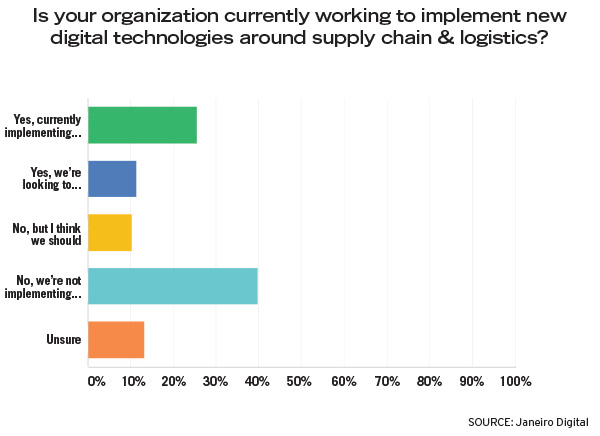Digital Supply Chains: The Modernization Gap

In supply chain and logistics, a wide chasm separates digital innovators from those that still rely on traditional, manual approaches to optimizing their operations. Janeiro Digital, a digital business consultancy, surveyed 98 mid- and senior-level supply chain managers to learn about this disparity in digital maturity.
With notable giants such as Amazon dominating the supply chain sector, it may be no surprise that the majority of respondents—84.7 percent—perceive themselves as average to behind the curve. What is surprising is that the largest group—50 percent of total respondents—report that they still aren’t implementing any new technologies (see chart). Only one in five of those reporting that their companies aren’t implementing new technologies believe this stagnation is the wrong move, reflecting the lack of desire to change.
On the other hand, of those who say their companies are looking to implement new technologies (36.7 percent), more than two-thirds (69.4 percent) report their organization has already started its digital transformation. This is often the case—companies will delay change, but once they get started they’ll shoot forward along the path to digital maturity, according to Janeiro Digital.
So how can companies kickstart their digital transformation journey?
The biggest challenge supply chain professionals say their organization encounters when looking to implement new technologies comes down to culture. Specifically, a lack of enthusiasm or support for change (23.5 percent) and unrealistic budgets (27.6 percent) are prominent issues, which point to the lack of appetite for change and a reluctance to put resources behind digital innovation.
Another prominent issue is legacy technology or infrastructure. Although only 4.1 percent of respondents feel their legacy technologies are holding them back from implementing new technologies, 23.5 percent indicate that they have encountered issues when it comes down to implementation.
In supply chain and logistics, tight margins make investments in new digital technologies feel risky. Inaction, however, is the riskiest long-term strategy a business can take. The decision to innovate, and ensuring you’re taking an approach to innovation that considers the technical realities of the business, is essential for finding long-term business stability and success, says Janeiro Digital.
